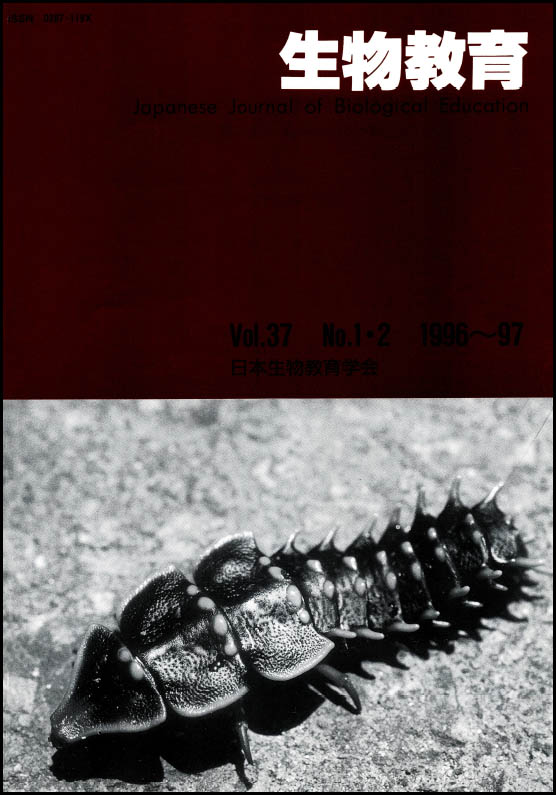
- Issue 3-4 Pages 98-
- Issue 1-2 Pages 2-
- |<
- <
- 1
- >
- >|
-
S. Hirama (Murayama), H. Kitano1997Volume 37Issue 1-2 Pages 2-8
Published: 1997
Released on J-STAGE: April 16, 2022
JOURNAL FREE ACCESSC. auratus is a popular fish in Japan. We can verify the respiration rate of the fish by counting the gill-beat cycle, the opening and closing movement of the operculum, and this can be used as a teaching material for elementary school pupils to measure respiration.
The relationships between the frequency of the gill-beat cycle to the water temperature and to the dissolved oxygen concentration in water were determined using 14 fishes ranging from 9 to 13 cm in body length.
It was confirmed that between 10°C and 30°C at a concentration of 7.5 mg O2/l in water, the higher the water temperature was, the higher the gill-beat cycle also was. Significant differences (P < 0.01) in the average gill-beat cycle were found when the water temperature went from l0°C (60.7cycle/min) to 20°C (110.2cycle/min) and again from 20°C to 30°C (148.9cycle/min). There was also a tendency for the average gillbeat cycle to increase as the dissolved oxygen concentration in water decreased at the temperature of 20°C From the above-mentioned experiments, most pupils should be able to understand the effects of temperature on the respiration rate of poikilothermal animals such as fish. The increased rate at which the fish respires in oxygen-deprived water also teaches the necessity of oxygen for living organisms.
View full abstractDownload PDF (23318K) -
K. Ohshika, H. Ikeda1997Volume 37Issue 1-2 Pages 9-16
Published: 1997
Released on J-STAGE: April 16, 2022
JOURNAL FREE ACCESSThe present authors have developed an internet on-line teaching resource on plant reproduction. This resource is different from any other one such as CD-ROM, since it is possible to use it with any computer operating system such as Windows, Macintosh system or Unix. By having access to this resource, users are able to view our original pictures and explanations of the reproductive organs in green algae, bryophytes, ferns, gymnosperms and angiosperms.
Two approaches, the systematic approach and the comparative approach, are included in this resource. The systematic approach is designed to study the plant organs and the reproductive system of each plant species. The comparative approach is designed to study similarities and differences of reproductive organs in several plant species. Therefore, users can freely use this resource according to their interest.
Taking advantage of the interactive function of the internet system, a questionnaire and a question box are added. Users can send back their answers to the questionnaire and their own questions. Therefore, the authors can obtain users'comments and requests to be used for improving this resource and the users can get additional information from the authors through e-mail.
View full abstractDownload PDF (21246K) -
T. Komatsubara, H. Kitano1997Volume 37Issue 1-2 Pages 17-23
Published: 1997
Released on J-STAGE: April 16, 2022
JOURNAL FREE ACCESSA small-scale mark-recapture experiment was conducted in a plastic container (10 × 15 × 7cm, water depth of 5cm) to clarify the relationship between the actual number of P. acuta in the container and the estimated population size. Population size was calculated by Petersen's method. Experiments were conducted for each actual population of 10, 20, 30, 40, 50 and 60 individuals of P. acuta in respective containers. For random sampling, the inner surface of the containers was divided into 16 quadrats (5 × 5 cm per quadrat). The marked shellfishes were released in the containers. Fifteen minutes after the release, the marked and unmarked animals were collected from randomly chosen quadrats. In the experiments, the number of the quadrats chosen varied from 1 to 8. From the release-recapture data, the authors concluded that the present technique gives reliable estimates for population sizes of 30, 40 and 50 individuals by using 8, 5 and 4 quadrats, respectively. Such a mark-recapture experiment wouJd be an ideal classroom experiment for estimating population sizes with living animals.
View full abstractDownload PDF (17781K)
-
H. Kaji1997Volume 37Issue 1-2 Pages 24-25
Published: 1997
Released on J-STAGE: April 16, 2022
JOURNAL FREE ACCESSDownload PDF (5487K) -
Y Koshida, N Taira, T Ikeda, S Iwatsubo1997Volume 37Issue 1-2 Pages 26-34
Published: 1997
Released on J-STAGE: April 16, 2022
JOURNAL FREE ACCESSDownload PDF (22780K)
- |<
- <
- 1
- >
- >|